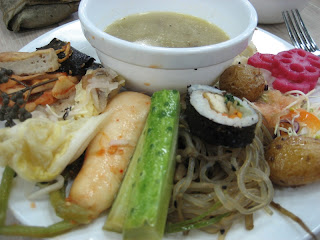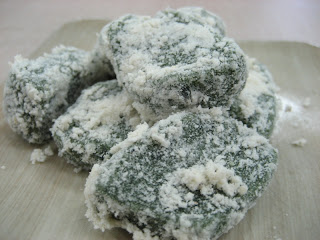Nosh: Buddhist Temple Cuisine, Korean Tea Party, and Kimchi-making, too!

One of the temples at the Bongeunsa Temple complex in Seoul.
There are some really neat perks to being a "foreigner"...although, technically, the Koreans seem to distinguish specifically between "Chinese", "Japanese", and "foreigner" (i.e., not East Asian). I guess I fit somewhere in between Chinese and foreigner.
Last week, there was a "foreigners" only event called "All That Is Temple Food - Cooking and Meditation," sponsored by the Jogye Order of Korean Buddhism and the Society for Traditional Temple Food Preservation at Bongeunsa Temple in Seoul. The night before the temple cuisine event, I had been to a pretty spectacular fundraiser for the NGO where I work and experienced the awesomeness of Korean planned events. The temple cuisine experience was no different - an already great event made extra good by the face that it was completely free! :)

One of our excellent guides during the day shows us around the temple grounds and explains the story of Buddha, as demonstrated on pictures around the temples.
So what is "temple cuisine" anyway? Obviously, I'm no expert on Buddhism or temple cuisine, but here is my attempt to explain briefly:
You may know that followers of the Buddhist faith are (or should be) vegetarians, not eating animals or animal products to respect life. Korea's (and probably other Buddhist countries') traditional temple cuisine obviously incorporates this vegetarianism, but also the fact that one's food must nourish the mind and spirit on the journey towards truth and Nirvana. Temple food takes into consideration the contributions of the environment/nature and, well, everything.
The event began with a morning lecture on Buddhism and some chanting, led by a really cheery, English-speaking Korean monk (who also served as translator for the other monks during the day - I'm sad I didn't catch his name!). Mind you, I was a little afraid that it would degrade into a "Let's recruit foreigners to be Buddhists!" session and I was going to end up with a shaved head and dressed in robes at the end of it all, but it didn't (hey, I've had some scarring experiences at fundamentalist churches before...). In fact, the morning lecture was really useful in informing us about the importance of tea ceremonies and eating as a way of meditation. Food meditation?!? How fascinating...!

Our host monks explaining to us the health benefits of our lunch. The female monk on the right is one of Korea's experts on temple cuisine.
Yeah, so the idea of "food meditation" sounds silly, but think about what meditation is - it's basically concentrating your physical and mental focus on one thing. In order to reach enlightenment, Buddhists have to meditate as much as possible...so what better way to multi-task than to meditate while eating?!?
The highlight of the day was the wholly unexpected and really lovely free meal that the temple provided for us. Wow! We even got to practice a bit of food meditation - eating in silence while savoring our food for forty bites per mouthful. Actually, it was a really neat experience. If you get a chance, try it! Not only does it allow you to savor the flavors of the food, but you really start thinking about all sorts of stuff (the consistency of the food, how your jaw moves as you chew, the muscle movements in your esophagus as you swallow, etc.).
Given the sacred nature of the day, it seems wrong to say this, but the following is a shameless demonstration of food porn (as so often utilized by Zen Kimchi).

Quite a spread! This isn't even the whole table!

Delicious kimbap, which is sort of like Korean sushi (sans the fish).

Lotus leaf rice (yeonnip bap) - one of my favorites in Chinese dim sum, but the temple cuisine version is neither salty or meaty.

An incredible soup that is supposed to capture the flavors of autumn. It certainly tasted like it!

Lotus roots pickled and naturally sweetened...in pomegranate juice?

A red rice porridge. Looks like red bean, but it wasn't sweet. Yummy!

At forty bites per mouthful, it took a little while to finish my plate. It was a deliciously long meal!
Obviously, meat and animal products are forbidden in temple cuisine, so it's pretty healthy stuff. All the ingredients are natural, so temple food does not contain any processed sugar, either. I also learned that there are five forbidden foods in Buddhism: onion, garlic, and leek (actually, three kinds of leek to make the forbidden foods = 5). Eating these foods raw stirs anger, and eating them cooked arouses sexual desire. Hmmm! Interesting! But anger and sexual misconduct are, of course, also forbidden by Buddha's teachings, so none of onion, garlic, or leek in temple cuisine thanks! This must be difficult, given the fact that Koreans eat garlic by bagful (really!).

In addition to the lovely meal, we foreigners were also treated to a traditional tea ceremony. Actually, it was much less formal than a Japanese Tea Ceremony, so, by contrast, it was almost a tea party! Again, the monks were great and took time to explain to us how to brew tea, hold our cups, etc.

A volunteer from the temple congregation, dressed in a traditional Korean hanbok, helps brew the tea.

Korean tea cakes. Not exactly crumpets, but way cooler! The red and green cakes are made of sweet beans, but the yellow is a very expensive cake made from compressed tree pollen! I'm surprised I didn't break out in hay fever when I ate it!

More tea cakes - this time, the glutinous rice variety.

Ready to smear!
We got a free book, The Korean Way of Tea, along with a box of (very expensive!!!) lotus tea for our participation in the day, but another free giveaway was kimchi that we got to make ourselves! And, of course, by "make ourselves", I mean that the hard-working monks and congregation volunteers salted the kimchi, prepared the red pickling sauce (no garlic and sweetened naturally with persimmon!), and dealt with all of the cleanup associated while all we foreigners did was slather the sauce all over the kimchi.

Voilà! It's takes college educated skill to smear Napa cabbage with red sauce, you know....yeah, the Gladlock container was free, too.
Temple cuisine has stayed the same for a long time, so in a way it's really one of the truly "traditional" foods of Korea, eaten before hot peppers and Mickey Dees came to the peninsula. It was really a pleasure to learn more about it and Buddhism, which is really an interesting philosophy and religion. If only I didn't like chicken so much and think that mosquitoes deserve to be destroyed (I'm sorry, Buddha). I hope others will be able to attend the same event next year, too. In fact, if you visit Korea in the future, you might consider temple stay to get the full experience!

3 Comments:
how did the compressed tree pollen cake taste? :)
Like chalk. But in a good kinda way. ^_^
I am interested in temple cuisine, this blog was great. Did you happen to learn about or get any cook books? I've been looking all over the internet...
Post a Comment
<< Home